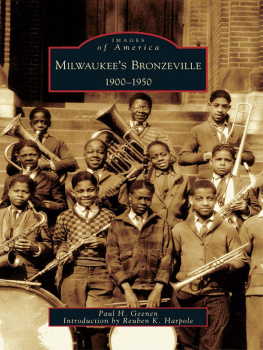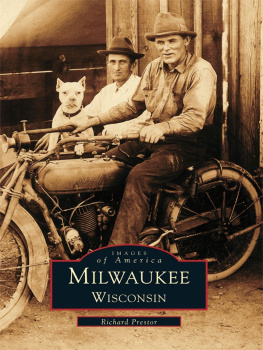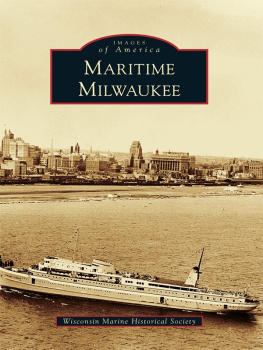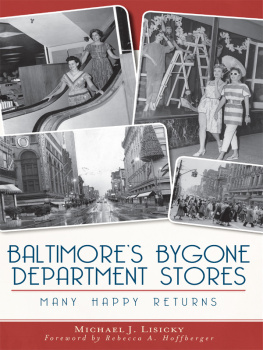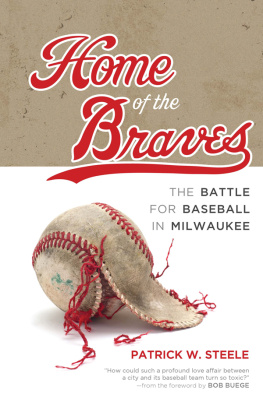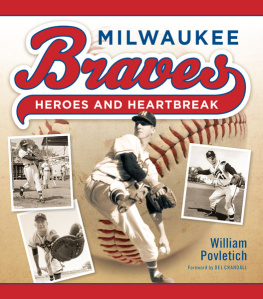Published by The History Press
Charleston, SC 29403
www.historypress.net
Copyright 2012 by Paul H. Geenen
All rights reserved
Front cover, top: courtesy of Bud Schneider; bottom: courtesy of Milwaukee County Historical Society.
First published 2012
e-book edition 2012
Manufactured in the United States
ISBN 978.1.61423.753.2
Library of Congress CIP data applied for.
print ISBN 978.1.60949.389.9
Notice: The information in this book is true and complete to the best of our knowledge. It is offered without guarantee on the part of the author or The History Press. The author and The History Press disclaim all liability in connection with the use of this book.
All rights reserved. No part of this book may be reproduced or transmitted in any form whatsoever without prior written permission from the publisher except in the case of brief quotations embodied in critical articles and reviews.
This book is dedicated to my wife, Patricia Geenen, whom I met at Geenens Dry Goods fifty years ago and who has supported and encouraged me ever since.
Contents
Preface
There is a tremendous amount of historical information available about Gimbels and Schusters. Both companies published employee newsletters, and every issue is on file at the Milwaukee County Historical Society. Much of my information comes from employee newsletters: Schusters Keeping In Touch, later called K.I.T., and the Gimbels employee newsletters, Broadcaster, Gimbelite and Front and Forward. These newsletters contain information about major developments, managements strategies and the work life of the employees at both companies. The Gimbels employee publications editor was probably responsible for the detailed history of Gimbels that was published over a number of years, printed on gold stock and distributed as an insert in various employee publications. These inserts were an important source for this book.
I interviewed people who worked in the stores, merchandise and support departments at Gimbels and Schusters. These interviews gave me background information that supplemented the information I found in my research. Some of my own experiences from working at Gimbels were included in the book also. I started in 1976 as a buyer and was divisional merchandise manager over the Marketplace before I left in 1983.
I leapt at the opportunity to write this book, as department stores have always been part of my familys DNA. My three great-auntsMinnie, Dina and Anna Geenenstarted a department store in Appleton, Wisconsin, in 1896. The three sisters started their store at a time when women were not considered able to manage on their own. Both my father and my mother worked at Geenens Dry Goods for many years. I worked in the store during the summer of my high school and college years and met my wife there. The store closed in 1966.
Minnie, Dina and Anna Geenen in the early 1900s. They are founders of Geenens Dry Goods in Appleton, Wisconsin. Courtesy of Paul Geenen.
The interior of Geenens Dry Goods, 1898 or 1900. Courtesy of Paul Geenen.
Time has passed, and events have become clearer. Department stores like to use hyperbole such as biggest, most or best. Information that could affect business was sometimes swept under the rug. It is now possible to take another look at the history of Gimbels and Schusters.
Acknowledgements
I wish to thank those who made this book possible, including Harold Badzinski, Irene Baer, Leon Boniface, Francis E. Bryant, Deidra Y.A. Edwards, Priscilla Franklin, Helene Furst, Phyllis Gorell, Mike Hammack, Humanities Department of the Milwaukee Public Library, Dave J. Johnson, Jack A. Koplin, Carol M. Larson, Michael J. Lisicky, Constance E. Little-Whiteside, Clark J. Miller, Milwaukee County Historical Society, Bill Orenstein, Stan Sapiro, Bud Schneider and Robert Schultz.
CHAPTER 1
Two Immigrant German Retailers
18421900
GIMBELS
Jacob Gimbel stood at the corner of what is now Wisconsin and Plankinton in 1886 closely observing the traffic that was going by this strategic location. He was the oldest son of seventy-six-year-old Adam Gimbel, the owner of the successful two-and-a-half-story dry goods store in Vincennes, Indiana, called the Palace of Trade.
Almost half the people walking by were family members of workers employed in Milwaukees vibrant industrial base of breweries, foundries, tanneries, meatpacking companies and flour mills. Heavy beer wagons carrying twelve barrelssix on each side, each stored at a forty-five-degree anglewere making their deliveries. A tall ship was tied up at the wharf a block east, with its topsails towering over everything. Officers and crews of ships came and went. Sleek horses pulled canopied, large-wheeled carriages.
Women in hoop skirts covering their high-button shoes, African American maids carrying packages for their middle-class matrons, men with derbies, boys with caps and immigrant workers from Eastern European countries were walking on the wide plank sidewalks while wagons filled with hides, beer and meat traversed the rutted dirt street. A scrabble of rocks lined the side of the street, offering pedestrians some means to keep their boots clean from the mud.
Streetcars, powered by newly electrified overhead cables, rode the rails silently, taking advantage of the brand-new power plant built by Wisconsin Electric Power Company. The twin streetcar lines, creating diamond patterns in the center of the intersection, extended, as John Gurda tells in his book The Making of Milwaukee, out to Wauwatosa, North Greenfield and Waukesha. The arched iron swing bridge angled to meet Wisconsin Avenue to the east and allowed wheeled and foot traffic to cross the river.
This was a good corner to sell newspapers, and newsboys with stacks of newspapers under their arms staked out their positions as soon as the papers came off the press. Men sitting straight and tall on bicycles peddled by slowly to maintain their dignity and to make sure their derby hats would not slip off.
A four-story buildingowned by the meatpacking tycoon John Plankingtonwith small colonnades around each of the nine windows on its upper floors stood empty on the corner. Harris Brothers Fair, Wholesale Confectionery and Lager Beer Hall had occupied it at different times in the past. All three businesses had opened and closed at this location, and the site was considered to be unlucky. Across the street, a ramshackle collection of narrow, two-story buildings was covered with signs; it would be kind to call this block over signed. The sign for Winklers Cigar Headquarters and a sign touting the incredible value of 3 shots for 5 cents indicated whose company the new Gimbels store would be keeping.
Jacob Gimbel knew his father was no stranger to taking risks. In May 1835, at the age of seventeen, Adam Gimbel had grown tired of toiling in the barons vineyards near the village of Rhein-Pfaltz, Bavaria, and had worked as a ships hand on a small square rigger to pay for his passage to New Orleans. He had already educated himself by learning Bible history from an itinerant rabbi, studied mathematics with a local Lutheran pastor and read books from the pastors library. As an eighteen-year-old dock worker, Adam Gimbel worked the wharfs, unloading the cotton, vegetables, wheat and other commodities traveling down the Mississippi on large, wood-fired paddle boats and loading cargo into the waiting sailing ships tied up at the wharfs. Adam Gimbel was a keen observer, taking detailed notes on what commodities and finished goods were being shipped up and down the river. He noticed itinerant peddlers with huge, waterproof packs on their backs hiking north with the goods from New Orleans for resale. These peddlers served the isolated farms along the Mississippi Valley, bringing both merchandise and the news for their farming customers. The peddlers would be warmly greeted when they arrived at local farms to sell their goods.


